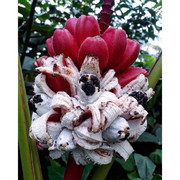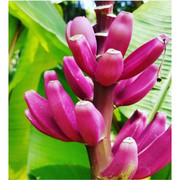Musa velutinaMusa velutina is a species of banana native to northeast India, Bangladesh, Myanmar, and southwestern China. It is commonly known as the pink banana or the hairy banana, due to its pink inflorescence and the velvety hairs on its pseudostems. The fruit of Musa velutina is small, about 3-4 inches long, and has a bright pink skin with soft, sweet, and flavorful flesh. While it is not widely cultivated for commercial use, it is a popular ornamental plant in gardens and landscaping due to its striking appearance.
Musa velutina, the hairy banana or pink banana, is a diploid species of wild banana. These plants are originally from Assam and the eastern Himalayas.
The fruits are 3 in (8 cm) long, pink, and fuzzy. They are borne on erect flower stalks with a pink inflorescence. Musa velutina flowers at a young age, doing so within a year. The fruits peel back when ripe.
It is often grown as an ornamental plant, but has soft, sweet flesh that can be eaten. The seeds are quite tough and can chip a tooth. To sow, first soak the seeds in warm water for 24 hours. They should be planted in fine compost and kept at a constant temperature of 20°-24 °C (68 to 75.2F) with full natural light. They take up to around 6 months to germinate.
Plants may be placed outside during warmer months but should be taken into a conservatory or greenhouse or given other protection in winter. Musa velutina has received the Royal Horticultural Society's Award of Garden Merit.
Kingdom: Plantae
Subkingdom: Tracheobionta
Superdivision: Spermatophyta
Division: Magnoliophyta
Class: Liliopsida
Subclass: Commelinidae
Order: Zingiberales
Family: Musaceae
Genus: Musa
Species: Musa velutina H. Wendl. & Drude



Price : 5$
Musa Ensete glaucumMusa Ensete glaucum, the snow banana, has also been classified as Musa nepalensis, Ensete giganteum, or Ensete wilsonii.
This gigantic monocarpic herbaceous plant is native to China, Nepal, India, Myanmar (Burma), and Thailand.
Ensete glaucum has a thick, waxy with sometimes bluish tinge, solitary pseudostem. It grows larger than the Abyssinian Banana (Ensete ventricosum).
Its leaves are 1.4–1.8 meters (4.6–5.9 ft) long and 50–60 centimeters (20–24 in) wide.
The plant is cultivated as an ornamental plant, for its unique swollen bulbous base and large leaves. and is used to feed pigs in parts of China.
In India the pulp of the fruit is eaten, considered highly medicinal, and given to infants and patients. Young shoots and a flowering part are eaten as a vegetable. The plant is used in religious and domestic celebrations.
It is easy to raise from seeds. It is an extremely fast growing banana given heat, but not as hardy as the Abyssinian Banana (Ensete ventricosum), and is not as well known
Ensete glaucum. a, b, Flowering plant; c, Mature inflorescence; d, Mature bud; e, Fruit; f, Immature inflorescence; g, Cross section of bud; h, Male flower; i, Female flower; j, Mature seeds.
It grows from 2,600–8,800 feet (790–2,680 m) in elevation.
The banana tree has a different shape on the stem of the fruit. The fruit stem is covered with green leaves resembling a dragon fruit but with a larger size and extends overhanging the heart of the banana. The heart of the banana is also green, not red like most other types of bananas.



Price : 3$
Musa Ensete superbumEnsete superbum is a species of banana from India. The plant is well-known from the Western Ghats, Anaimalai Hills, some other South Indian hills in Dindigul and other parts of the peninsular India. It has also been recorded from Jhadol and Ogna forest ranges in Rajasthan, North India. There are also reports of a similar species in Thailand, but it is yet to be formally described.
Plants may grow up to 12 ft in height and the pseudostem may be up to half the height with a swollen base of up to 8 ft in circumference at the base. The leaves are bright green in colour on both sides with a deeply grooved and short petiole. The leaf sheaths are persistent at the base and leave closely set scars on the corm. The fruits are about 3 inches long and more or less triangular with dark brown seeds. The upper parts of the plant die out during the dry season leaving the corm, which forms new leaves at the beginning of the monsoon.
The species is native to Assam, Myanmar, northern Thailand and north-western India, where it grows in the deciduous and semi-deciduous forests in the valleys and along the rocky hill slopes.
The name of the genus is the local (Abyssinia) one referred to the Ensete ventricosum; the name of the species is the Latin adjective “superbus, a, um” = superb, magnificent, with obvious reference.
Common names: cliff banana, rock banana, western hill banana, wild plantain (English); jungli kela (Hindi); bahuja (Sanskrit); kluai pha (Thai).
The Ensete superbum (Roxb.) Cheesman (1948) is an erect monocarpic rhizomatous herbaceous species with single stem, 3-3,5 m tall, with pseudo stem formed by the persistent foliar bases strictly wrapping one over the other, almost conical, 0,9-1,2 m tall with a diameter of about 70 cm at the base and 30 cm at the apex under the leaves. The leaves, on a deeply grooved petiole, are simple, entire, oblong-lanceolate, 1,5-3 m long and 50-90 cm broad, of bright green colour. The inflorescence is a curved terminal spike on a robust peduncle, 0,5-1 m long, with groups of 10-15 flowers arranged on two series along the floral axis, each one covered by thick ovate bracts, about 25 cm long and 20 cm broad, opening in succession, persistent, of reddish brown colour. At the base of the inflorescence are present female flowers, followed by the male ones in the terminal part. The fruits are oblong berries with almost triangular section, about 7 cm long and of 3,5 cm of diameter, containing subglobose blackish brown seeds rather angulate due to the mutual pressure, of 0,8-1,2 cm of diameter.
In the humid warm regions it is evergreen with three years life cycle, in the monsoonal ones the aerial part dies during the dry season and grows again during the rain season, with a four years cycle.
It reproduces by seed, previously kept in water for two days, in sandy loam maintained humid at the temperature of 26-28 °C with variable germination times starting from about one month, and by micropropagation. It can be propagate vegetatively by cutting at the base the pseudo stem of a plant who is on the way of blooming and emptying the rhizome at the centre and filling it with topsoil, in this way we may get some plants that can be detached, not simple operation and, of course, at the expense of the mother plant.
Fairly rare species with magnificent foliage, cultivable in the humid tropical and subtropical zones, its cultivation may be tried in the warm temperate ones where temperatures of some degree lower than 0 °C are short lasting exceptions. Can be utilized isolated or in group in parks and gardens in full sun or slight shade and sheltered from the winds which would harm the large leaves; it is not particular about the soil, even poor, provided draining, constantly maintained humid during the vegetative period. It can be cultivated in capacious containers, in organic loam with addition of sand or agri-perlite per 30%, for the decoration of greenhouses and particularly luminous winter gardens, with winter lowest preferably not under the 10 °C; the waterings must be regular and abundant in summer, more spaced in winter allowing the substratum to dry up almost completely.
The species has also a special religious meaning in the Buddhist culture and is planted close to the monasteries.
Since long time the ground seeds are used in the traditional medicine for various pathologies; laboratory studies have evidenced in the extracts the presence of bioactive substances such as alkaloids, phenols, flavonoids, saponins, etc. and anti-inflammatory activity which requires further studies.
Classification
Kingdom: Plantae
Division: Spermatophyta
Sub-division: Angiospermae
Class: Monocotyledonae
Series: Epigynae
Family: Scitamineae
Sub-family: Musaceae
Genus: Ensete
Species: superbum


price : 7$